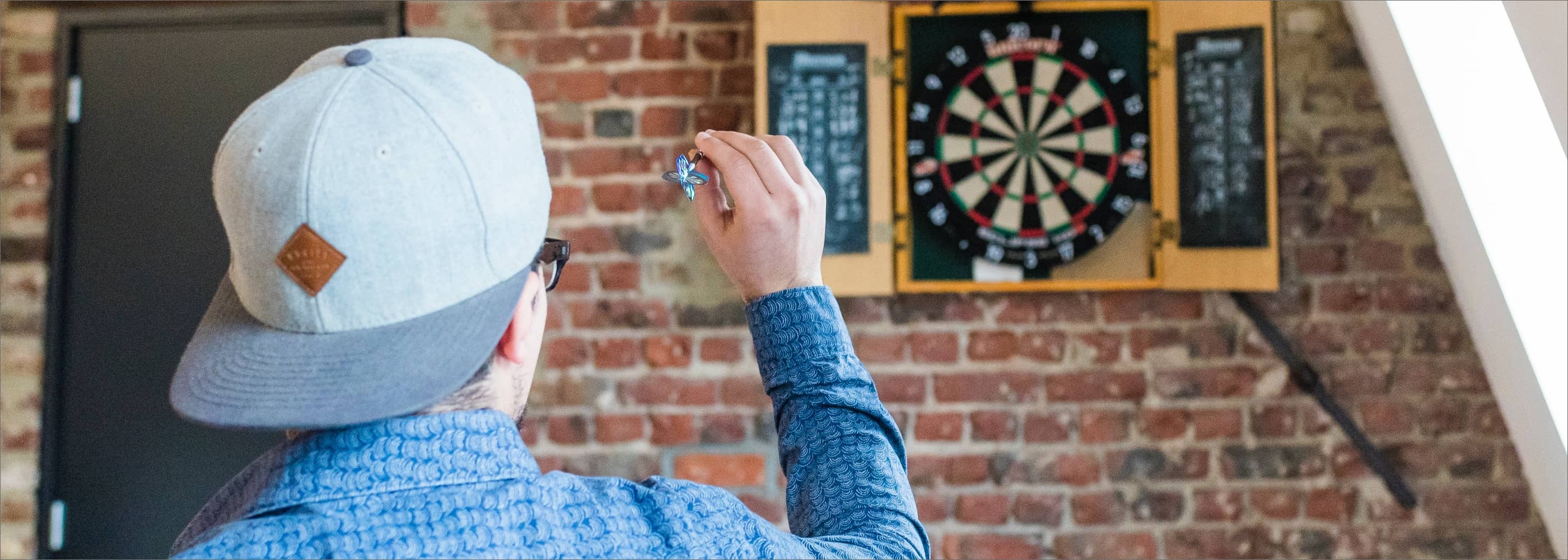Darts basics, or how should I build my home set?
Playing darts at home is not only fun, but also a great way to spend time with friends and family while developing concentration and skill. However, before you start playing, it is important to prepare yourself properly and put together a quality darts set. In this blog post, we will discuss in detail how to choose the right darts equipment for home use.
Should I Buy a Soft or Steel Darts Board?
The first and most important question you will face is what type of board to choose. A dart board can be soft (for plastic-tipped darts) or steel (for steel-tipped darts). A soft dart board is worth choosing if all members of the family play, especially if younger children want to participate in the game. Thanks to the plastic tip, soft darts are gentle on the walls, but they are also great for beginners and hobby players. There are also types available that have a built-in calculator and game mode selector, so you can get started with the game as an all-in-one device.
The most popular series are played with steel dartboards without exception. The game is equally difficult for both types of dartboards, but steel dartboards are considered more common and it is easier to spot errors in the throw. This is because with soft dartboards, every incoming dart will land in the same way (perpendicular to the dartboard) to create holes in the dartboard (at least if it doesn't pop out). This can be a problem because it will be much harder for you to figure out if there is an error in your throwing technique and what changes you should make to become more accurate and consistent. With steel dartboards, if the dart flies poorly, the angle of arrival will also be the same.
What Quality Board Should You Choose?
The quality of the board is essential. It is possible to buy a dart board made of paper in the entry category, but this is only recommended if it is expected to be used infrequently, because these boards do not have a significant regeneration, unlike boards made of sisal. The largest selection available on the market is made of sisal hemp boards - and not by chance. These boards are miles ahead of their paper counterparts in terms of durability. From here on, there are differences between the individual types that seem minor, but have a greater impact on the game experience. The first and perhaps most important is the wiring of the board. In the beginning, it was considered standard, but now the round wiring that is attached to the surface of the board with clips is outdated. In this solution, a relatively thick, round wire is routed through each sector, the biggest drawback of which is that the playing surface becomes noticeably smaller, so it can become particularly problematic above a certain level of playing skill. Also, due to the thicker wire, the number of arrows that bounce off is significantly higher than the sector separation method with blade wire made according to today's professional standards and embedded in the board material.
Based on the above, I would like to distinguish three buyer motivations and the corresponding choice. Of course, there are plenty of choices within these, so if you get stuck, don't hesitate to contact me with your question at any of the contact details .
Quality and a professional (like) darts setup are important, you want to improve in this sport and you plan to visit your board relatively regularly. If you know yourself, then a board with a blade and recessed wiring is worth choosing.
You are planning a medium amount of games, you are just getting to know the sport but you are not yet sure that it will be love at first sight. In this case, round wire boards can be considered, in which the use of high-quality materials remains, "only" the playing surface will be smaller.
The goal is to have simple functionality. Here, even paper signs can come into play.
Extending the Life of the Board
Finally, ensure that the board is properly maintained to extend its lifespan. Rotate the board regularly (two segments so that the 20 sector is always black) so that it is used evenly. Personally, I like to rotate it counterclockwise because in this case the most used sector (triple 20) will be sector 12, which is used significantly less often than sector 18. It is worth using a darts mat during the game, because depending on the surface, we need to protect either the surface (soft surface e.g. laminate floor, parquet, etc.) or the arrow tip (hard surface: porcelain stoneware, tiles, concrete, etc.) from bouncing arrows. In the latter case, the arrow tip will be chipped, thus causing greater damage to the board with each throw.
What Should The First Arrow Be Like?
Choosing your first arrow is a crucial step. I cover this topic in detail in my blog post “HOW TO CHOOSE AN ARROW?” so I’ll just summarise the gist here. As a beginner, it’s a good idea to choose a medium-weight (21-24g) straight arrow with a “grip” along the entire length of the arrow. This is because you won’t necessarily know where you’ll be holding the arrow at first. If you have access to a nearby darts club or friends who have their own sets, it’s a good idea to ask them to give you a try. Luckily, most places are very friendly about this, so most will let you try them out. Experiment with different arrow weights and designs to find the one that suits your hand and throwing style best. It is important to note here – and it is advisable to prepare for this in your mind – that the first arrow you buy will almost certainly not be the last. If you like the sport and love to play, it is worth choosing an arrow with at least 80% tungsten and playing with it for at least half a year. During this time, your throwing style will develop significantly and you will know what you are missing from your arrow. More/less grip, different grip point, different center of gravity, different weight, etc.
Darts Rules: Learn the Basics of the Game
Before you start playing, it is worth familiarizing yourself with the rules of the game. The rules of the game of darts are simple, yet they provide an exciting gaming experience. The two most well-known and most played types of darts are:
701/501/301/201 or also known as X01
The most popular formats, where the goal is to reduce the starting score to 0. Here, depending on the level of the players, double in or out can be chosen. In PDC tournaments, 501 double out game formats are used.
Cricket:
In Cricket, the goal is to close sectors 15 to 20, as well as the bullseye, before your opponent does. To close a number, you need to hit that number three times (of course, doubles are worth two and triples are worth three).
If a player closes a number and his opponent has not yet closed the same number, the player receives points equal to the sector value. (So if the player rolls a T20-S1-S20, 80 points are added to his points)
The game is won by the player who has closed all numbers from 15 to 20 and the bullseye and has more points than the opponent.
Darts basic rules
The throwing line must be 2.37 cm from the plane of the board and the center of the board must be 173 cm high.
Scoring: The rolls are scored based on the numbers on the board, where within each sector there is a triple and a double area. These areas, as their name suggests, are worth double or triple the value of the given sector. Based on this, the maximum score on the board in a round is 180, which can be achieved by hitting the triple 20 with three arrows. The Bullseye (center red area) is worth 50 points, the outer circle (green) is worth 25 points.
Exit: The player must reduce his remaining points to exactly zero by doing so with a double or Bullseye segment. If, for example, the player has to exit with 40 points but rolls 41 or higher, his points remain unchanged. Staying with our example, if the player rolls 39 points, his points do not change because the lowest double number on the board is double 1, i.e. 2 points. In the case of a friendly game, if the average skill of the players requires it, it is possible to abandon the double sector rule, thus ending a round with a single, double or even triple sector.
I hope that with these tips you can confidently choose darts equipment for your home game. If you are still unsure, do not hesitate to contact me at one of my contacts . Remember, darts is a game that brings fun and challenge to your life, so enjoy every moment with your friends and family!













Leave a comment
This site is protected by hCaptcha and the hCaptcha Privacy Policy and Terms of Service apply.